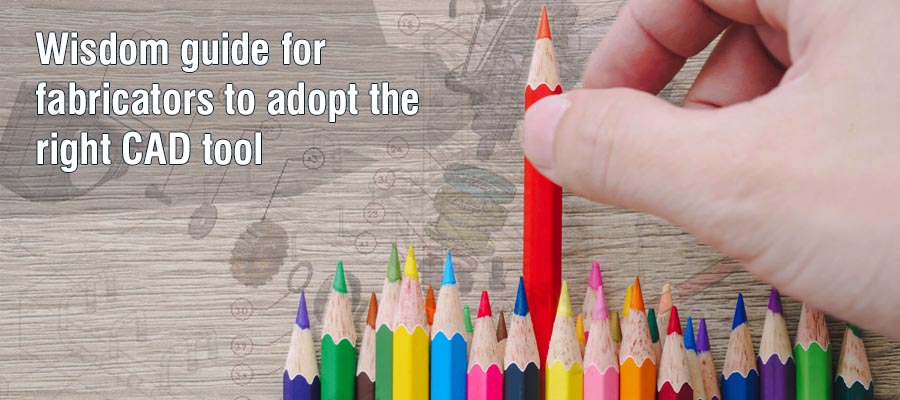
Fabrication/manufacturing is a very discrete industry and is on a run to shift towards additive manufacturing instead of the conventional machining process. And as a result, 3D CAD sketching and modeling tools are accepted as the most lucid geometrical medium for design articulation. In the wake of this constant attraction of fabricators towards CAD, software companies have a line of CAD software modules floating in the markets.
It can be a real overwhelming situation while selecting one bets CAD tool for all your needs. However, there always are ways to select the one system that satisfies most of your requirements. Any new CAD licensing should cater the following:
Everything from geometric to generative
To put it in plain words, the purpose of 3D isn’t just modeling. It is extended to attain seamless manufacturing, to achieve increased efficiencies of the designer, and, in turn, have controlled the generation of NC machines. As a result, fabricators need 3D models that are more suitable to production environment with optimized topologies.
Engineers are often required to produce parts that are light in weight, accurate in geometry and high precision tolerances. It so happens that these features are thought of right at the design stage. Thus, a CAD system that can let the design engineer think about all the geometry and topology features at once is the ideal.
One that is quicker in designing
Also, it goes without saying that whenever topology is involved, design changes are inevitable. If there is a CAD system that can make your designs even with 20 percent fewer steps will bring out great cost and efficiency benefits.
Hypothetically, assume that there are 60 steps and it takes about an hour to model a sheet metal part in a CAD system – A. So it means on an average one step takes a minute to give the command and display output model. And on the other hand, another CAD tool, – CAD B, can make the same part with the same accuracy in say 20 percent lesser steps. This means there are only 42 steps in CAD system B. Imagine the time saved and costs saved with this reduced 12 steps.
This is a case of first-time modeling. Actual bigger benefits will be reflected when ECOs are issued from the shop floor. A real CAD system will not only combine exceptional technical competences but also reflects gains over the cost of ownership through quick ROIs.
Seamless flow of information exchange with external enterprise
Whether you are a manufacturer, designer or the dealer, sharing CAD models along with the product is a good way to benefit more for marketing and affiliation purpose. It certainly results in inconsistencies when one CAD file is accessed in another system without a format conversion process.
To avoid this hustle, the bottom line is choosing a CAD system that is widely used across the industry and the one that supports neutral CAD files such as STEP/IGES. However, the only challenge with these neutral formats will strip off data from the original models upon the access. Thus, one shall use a feature based or direct model in a CAD system that most designers and fabricators prefer.
When in confusion, turn to a CAD design support partner, who understands your need for interoperability across the process and helps you through.
One that can see through the product development stages
There has been a drastic difference in the CAD usability since it was first introduced to the current commercial CAD systems. The initial 2D has been upgraded to PMI annotated 3D, MBD, APIs, design automation and compatibility to other domain-specific tools.
It clearly means CAD is virtually present in every stage of product development, from conceptual design through manufacturing. Selecting a CAD system that manages the well with a sort of software library, commonly referred to as CAD Locker or CAD vault is essentially the need of the hour.
Even during manufacturing stages, NC programs, accurate GD&Ts, inspection of fabrication drawings and BOMs release for order quantity need error-free commissioning. A CAD system delivering MBD will solve all these issues once and for all.
And lastly as said earlier, CAD systems have continuously been evolving since their first introduction because of the constant expansion in software technology knowledge. So if a vendor isn’t keeping up with the evolving markets of CAD systems, chances are more that the vendor will be thrown out of the race real soon as a choice of R&D and design development teams.
However, thinking that there exists a single CAD system that serves all these aforementioned needs will be a big folly; because it doesn’t. Rather, the wisdom lies in selecting a CAD system/tool that addresses most of the fabricators’ needs.
Related Glossary Terms
- computer-aided design ( CAD)
computer-aided design ( CAD)
Product-design functions performed with the help of computers and special software.
- numerical control ( NC)
numerical control ( NC)
Any controlled equipment that allows an operator to program its movement by entering a series of coded numbers and symbols. See CNC, computer numerical control; DNC, direct numerical control.







